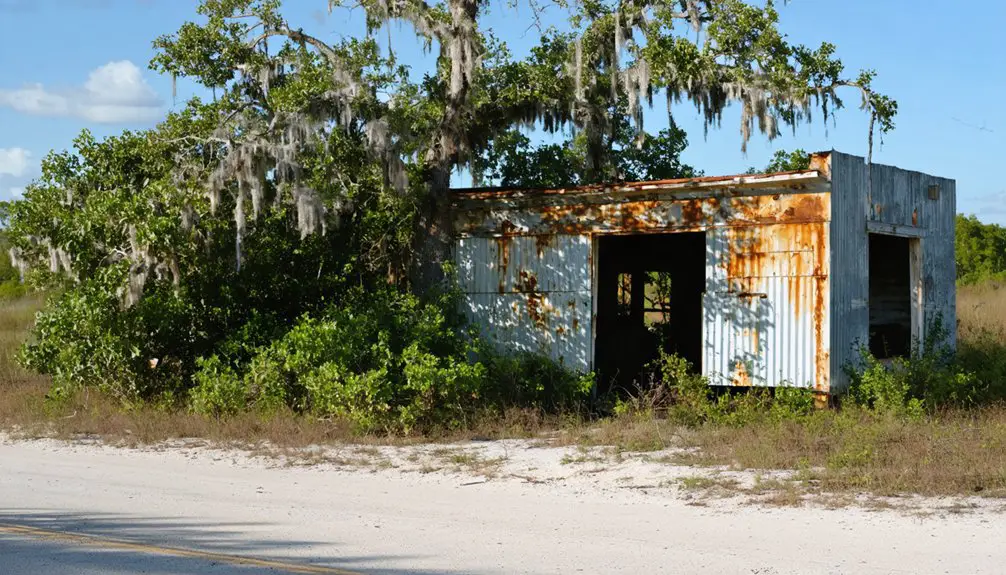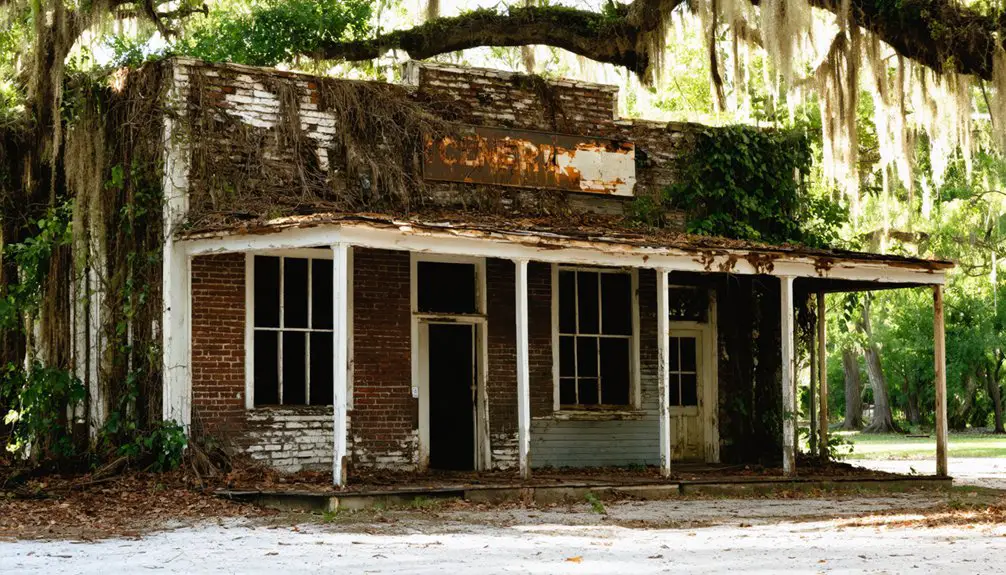You’ll discover Goodno, Florida along abandoned railroad tracks as a ghost town that emerged in 1921 during the Atlantic Coast Line Railroad’s expansion. E.E. Goodno transformed it into a bustling hub with hotels, stores, and cattle operations, attracting notable figures like Henry Ford and Thomas Edison. After Ford’s 1924 property purchase and a catastrophic 1926 hurricane, the town’s decline began. Today, nature reclaims the scattered remains, holding untold stories of Southwest Florida’s past.
Key Takeaways
- Goodno was established in 1921 as a Florida railroad town but became abandoned after a devastating hurricane in 1926.
- The town flourished briefly as an agricultural and trading hub, attracting notable visitors like Henry Ford and Thomas Edison.
- E.E. Goodno developed the town with a hotel, cattle operations, and agricultural innovations before selling to Henry Ford in 1924.
- The removal of railroad tracks and destruction from the 1926 hurricane led to business closures and resident abandonment.
- Today, Goodno exists as a ghost town with scattered ruins and artifacts being reclaimed by Florida’s natural landscape.
The Birth of a Railroad Town
As the Atlantic Coast Line Railroad pushed southward through Florida in 1921, the small town of Goodno emerged alongside its newly constructed tracks.
You’d find this pioneering settlement situated along a significant 26-mile stretch of railway that connected the Caloosahatchee River to Immokalee, marking a notable phase of railroad expansion in the region.
The town’s focal point was its general store, established in 1921, which served the growing community of railroad workers and settlers. Like nearby Fort Denaud, the area became known for its thriving citrus operations.
The bustling general store anchored daily life in Goodno, providing essential supplies to workers and pioneers along the railway line.
As the first train rolled through on October 16, 1921, Goodno became an essential hub for weekly mail delivery and freight services. The Moore Haven Railway acquired this section of track in 1925, continuing the vital transportation link.
The railroad’s presence spurred community development, bringing necessary infrastructure like post offices and schools.
You’ll see how this strategic location helped transform southern Hendry County from frontier wilderness into a connected agricultural economy.
E.E. Goodno’s Vision and Legacy
Ambition drove E.E. Goodno to transform Southwest Florida when he arrived in 1898.
You’ll find his legacy in every corner of what’s now La Belle, where he purchased vast tracts of land and established a thriving cattle operation.
Like many early Florida settlements, Goodno’s community emerged during the state’s rapid growth in the early 1900s.
Goodno’s ambitions extended beyond ranching – he built the Fort Thompson Park Hotel and developed agricultural innovations that made the region’s fertile soil work harder for local farmers.
The hotel became a bustling destination that attracted potential residents to the growing region.
Even after selling his holdings to Henry Ford in 1924, Goodno stayed on as property manager, continuing to shape the area’s development.
When he died in 1936, he’d already laid the groundwork for modern La Belle.
His pioneering spirit lives on through historical markers near Fort Thompson, reminding you of a visionary who saw potential in untamed Florida wilderness and built an enduring agricultural empire.
Economic Hub Along the Caloosahatchee
The Caloosahatchee River transformed Goodno’s settlement into a bustling economic center in the early 1900s. You’d find steamboats maneuvering the waterway, transporting passengers and cargo despite the challenging twists and shallow depths. Dredge boats, like Captain Melville’s in 1908, worked tirelessly to maintain passable channels for river trade. Captain Francis Asbury Hendry purchased vast tracts of land in the area after the Seminole Wars in 1879.
Along the riverbanks, agricultural expansion flourished with sugar cane farms, sawmills, and livestock operations. The construction of the LaBelle Bridge connected Lee and DeSoto counties, sparking new commerce opportunities. The area’s development accelerated after major flooding events in 1926 and 1928.
Businesses clustered near the waterfront, with grocery stores staying open late to serve the community. Even after setbacks like the 1928 downtown fire, the area’s economic significance persisted through industrial developments, including the strategic placement of railroad depots, cattle pens, and sugar mills near river crossings.
Notable Visitors and Golden Era
During its golden era spanning from the late 1800s to early 1920s, Goodno attracted several prominent figures who shaped America’s industrial landscape.
You’d have found Henry Ford, Thomas Edison, and Harvey Firestone among the prominent guests at the Fort Thompson Park Hotel, which served as the town’s social hub under Edgar Everett Goodno’s ownership.
The area thrived through agriculture, cattle ranching, and trade until 1924, when Ford purchased the entire Fort Thompson Park and La Belle property from Goodno.
Before the town’s peak, it primarily served as a railroad boarding point for cattle destined for Cuba.
While Ford’s involvement brought additional prestige to the region, the devastating 1926 hurricane marked the end of Goodno’s golden age.
The town’s decline followed swiftly, leaving only the 1921 general store and a single house as remnants of its prosperous past.
Like other Florida ghost towns such as Ellaville, which saw its post office close in 1942, Goodno gradually faded into obscurity.
Infrastructure and Daily Life
Life in Goodno revolved around robust transportation and commercial infrastructure that supported its growing population. You’d find the town strategically positioned along E.E. Goodno’s railroad line, with community facilities clustered around the crossing at State Highway 80, about 6 miles east of LaBelle.
The 1921 General Store anchored the town’s commerce, while essential services like the sawmill, cement plant, and ice plant kept daily operations running smoothly. Like many Florida settlements of the era, Goodno exemplified the state’s boom-bust cycle pattern.
Similar to Highlands County’s early days, travel was difficult with primitive transportation limiting access to neighboring areas.
Transportation routes connected residents to regional hubs via 2-wheel drive roads, while the railroad facilitated cattle shipments to distant markets, including Cuba.
You could power your business from the town’s generator building, cool your goods at the ice plant, or gather with neighbors at the dining hall and hotel.
Until the devastating 1926 hurricane, these interconnected systems maintained Goodno’s self-sufficient character.
The Path to Abandonment
While Edgar Everett Goodno had established a thriving community through his extensive land purchases and business ventures, financial strain began unraveling the town’s fabric in 1924 when he sold his properties to Henry Ford.
You’ll find the community decline accelerated through a series of devastating blows. The removal of railroad tracks cut off crucial transportation links, isolating Goodno from larger markets.
Then, in 1926, a catastrophic hurricane struck, destroying homes and flooding the area. The environmental impact crippled farming and livestock operations, while rebuilding proved financially impossible.
As businesses shuttered and services vanished, including the hotel and ice plant, residents gradually abandoned the settlement. Ford’s shift to industrial-scale agriculture sealed Goodno’s fate, transforming a once-bustling community into a ghost town.
Geographic Remnants Today

Today’s remnants of Goodno reveal a landscape slowly reclaimed by nature, where abandoned buildings and degraded infrastructure stand as silent witnesses to the town’s past.
If you’re interested in ghost town tourism, you’ll find scattered debris and old equipment that offer glimpses into the area’s former daily life. You’ll spot distinctive features like pigeon coops and vintage trucks perched on nearby hills, though tall grass and encroaching vegetation increasingly obscure these artifacts.
For remnant exploration, you’ll need to navigate unmaintained roads and possibly hike to access the site.
While there’s limited formal documentation of Goodno’s remains, you’ll discover a growing wildlife presence and natural reclamation that’s transformed this once-active community into a reflection of Florida’s forgotten places.
Frequently Asked Questions
What Happened to the Residents of Goodno After the Town’s Decline?
When push came to shove, you’d find residents’ migration led them to LaBelle and Clewiston. Economic factors and lost railroad jobs forced them to seek opportunities in larger towns.
Were There Any Schools or Churches Established in Goodno?
You won’t find any documented schools or churches in Goodno’s education history or religious significance. The small cattle town lacked permanent community institutions before its decline following the 1926 hurricane.
What Natural Disasters, if Any, Impacted Goodno’s Development?
You’ll find the devastating 1926 hurricane had the biggest impact, demolishing most homes. Regular flooding from the Caloosahatchee River also disrupted life, forcing residents away and hindering development.
Did Any Significant Crimes or Conflicts Occur in Goodno’s History?
You won’t find any documented crime incidents or historical conflicts in Goodno’s records. The town’s story focuses on cattle trading, land development, and natural challenges rather than social unrest.
What Native American Tribes Originally Inhabited the Goodno Area?
Like layers of ancient earth, your land first knew the Potano and Timucua peoples. Later, Creek Nation refugees merged into the Seminole Tribe, who’d make this territory their stronghold until forced south.
References
- https://freepages.history.rootsweb.com/~gtusa/usa/fl.htm
- http://wikimapia.org/5955161/Goodno-ghost-town
- https://www.youtube.com/watch?v=o-Am_LvFCuk
- https://en.wikipedia.org/wiki/List_of_ghost_towns_in_Florida
- https://www.ghosttowns.com/states/fl/goodno.html
- https://sites.rootsweb.com/~flhendry/towns.html
- https://en.wikipedia.org/wiki/Haines_City_Branch
- http://floridahistory.org/railroads.htm
- https://storymaps.arcgis.com/stories/aeeb4227eb1543e4aec219200f9c986e
- https://www.goodenowfamily.org/ghosts.htm



